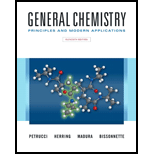
Concept explainers
(a)
Interpretation:
Interpret the possible reaction of propyne with given reagents.
Concept introduction:
Propyne is an
(b)
Interpretation:
Interpret the possible reaction of 4-hydroxy-2-butanone with given reagents.
Concept introduction:
4-hydroxy-2-butanone is a hydroxyl
(c)
Interpretation:
Interpret the possible reaction of benzoic acid with given reagents.
Concept introduction:
Benzoic acid is an aromatic carboxylic acid with −COOH group directly bonded with benzene ring. Since it is an
Want to see the full answer?
Check out a sample textbook solution
Chapter 26 Solutions
GENERAL CHEMISTRY-MOD.MASTERINGCHEM.
- What reactions are needed to convert alcohol A to either alkyne B oralkyne C?arrow_forwardLike alcohols, ethers undergo a cleavage by breaking a carbon–carbon bond between an alkyl group and the carbon bonded to the ether oxygen atom; that is, the red C–C bond in R–CH2OR' is broken. With this in mind, propose structures for the fragments formed by a cleavage of (CH3)2CHCH2OCH2CH3. Suggest a reason why an ether fragments by acleavage.arrow_forwardDisiamylborane adds only once to alkynes by virtue of its two bulky secondary isoamylgroups. Disiamylborane is prepared by the reaction of BH3 # THF with an alkene.(a) Draw the structural formulas of the reagents and the products in the preparation ofdisiamylborane.(b) Explain why the reaction in part (a) goes only as far as the dialkylborane. Why isSia3B not formed?arrow_forward
- 6.22 Write the structure of the major organic product formed in the reaction of 1-pentene with each of the following: (a) Hydrogen chloridearrow_forwardAcid-catalyzed hydration of 2-Methyl-1-butene yields two alcohols. The major product does not undergo oxidation, while the minor product will undergo oxidation. Explain why, by showing the structures of theproducts.arrow_forwardA is a compound with molecular formula of C6H10, contains three methylene units. A react with one equivalent of H2 over Pd/C to yield B. A reacts with aqueous acid to form a single product, C. A also undergoes hydroboration/ oxidation to form product D. Ozonolysis of A followed by reaction of dimethylsulfide form E with molecular formula C6H10O2. A react with bromine in dichloromethane form F with molecular formula of C6H10Br2. Draw the reaction scheme for all the reaction mentioned above and suggest structure for A – F.arrow_forward
- a. What is the chemical structure of biphenyl? b. Is it polar or nonpolar? _______________________ c. What is its water solubility in g/L? __________________________arrow_forwardWrite the structures of the products when Butan-2-ol reacts with the following:(a) CrO3(b) SOCl2arrow_forwardAn unknown hydrocarbon A with the formula C6H12 reacts with 1 molar equivalent ofH2 over a palladium catalyst. Hydrocarbon A also reacts with OsO4 to give diol B. When oxidized with KMnO4 in acidic solution, A gives two fragments. One fragmentis propanoic acid, CH3CH2CO2H, and the other fragment is ketone C. What are thestructures of A, B, and C? Write all reactions and show your reasoning.arrow_forward
 ChemistryChemistryISBN:9781305957404Author:Steven S. Zumdahl, Susan A. Zumdahl, Donald J. DeCostePublisher:Cengage Learning
ChemistryChemistryISBN:9781305957404Author:Steven S. Zumdahl, Susan A. Zumdahl, Donald J. DeCostePublisher:Cengage Learning Chemistry: An Atoms First ApproachChemistryISBN:9781305079243Author:Steven S. Zumdahl, Susan A. ZumdahlPublisher:Cengage Learning
Chemistry: An Atoms First ApproachChemistryISBN:9781305079243Author:Steven S. Zumdahl, Susan A. ZumdahlPublisher:Cengage Learning
 Chemistry for Today: General, Organic, and Bioche...ChemistryISBN:9781305960060Author:Spencer L. Seager, Michael R. Slabaugh, Maren S. HansenPublisher:Cengage Learning
Chemistry for Today: General, Organic, and Bioche...ChemistryISBN:9781305960060Author:Spencer L. Seager, Michael R. Slabaugh, Maren S. HansenPublisher:Cengage Learning Organic ChemistryChemistryISBN:9781305580350Author:William H. Brown, Brent L. Iverson, Eric Anslyn, Christopher S. FootePublisher:Cengage Learning
Organic ChemistryChemistryISBN:9781305580350Author:William H. Brown, Brent L. Iverson, Eric Anslyn, Christopher S. FootePublisher:Cengage Learning




